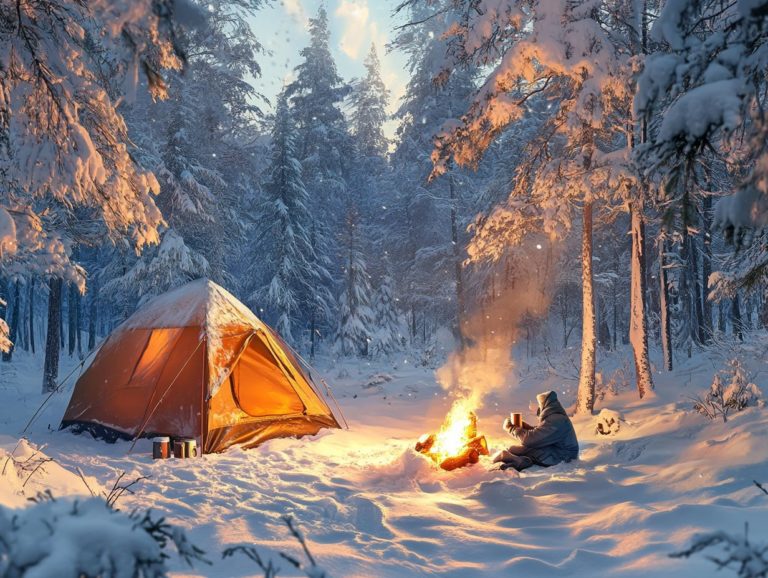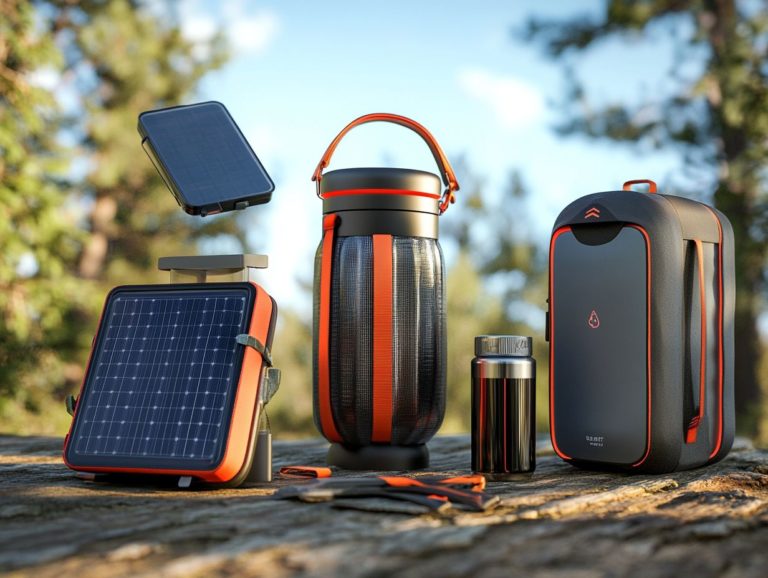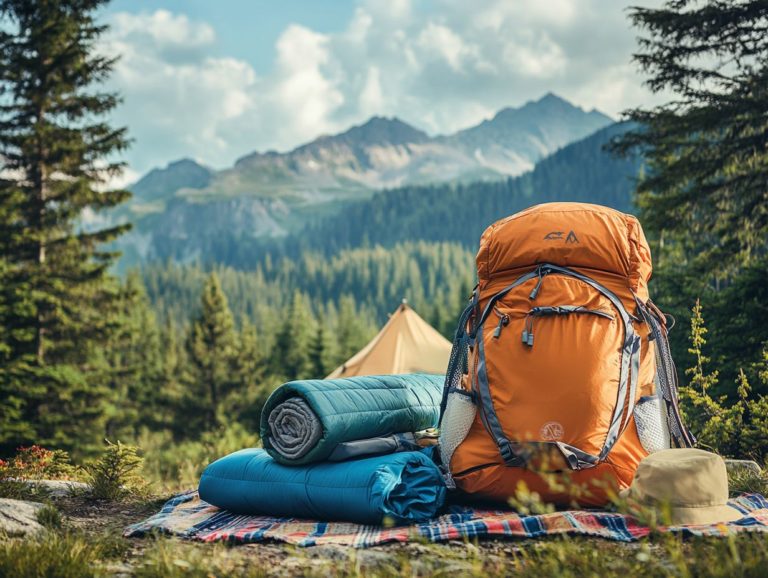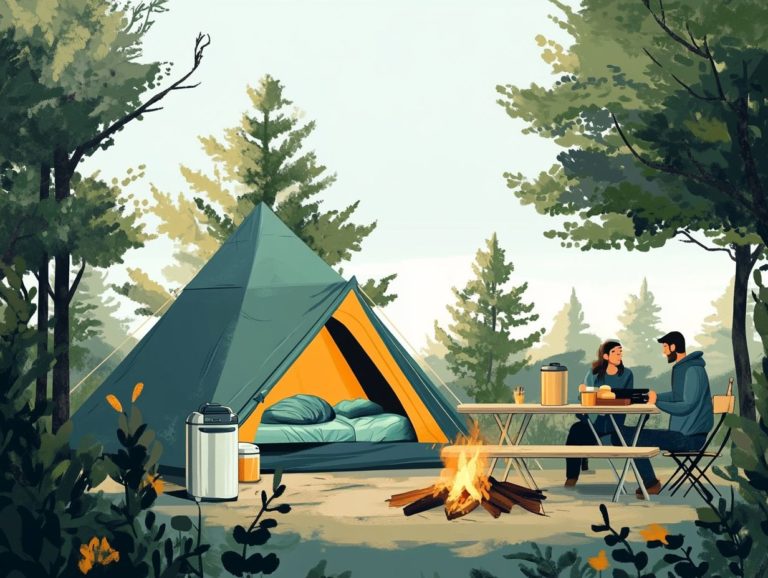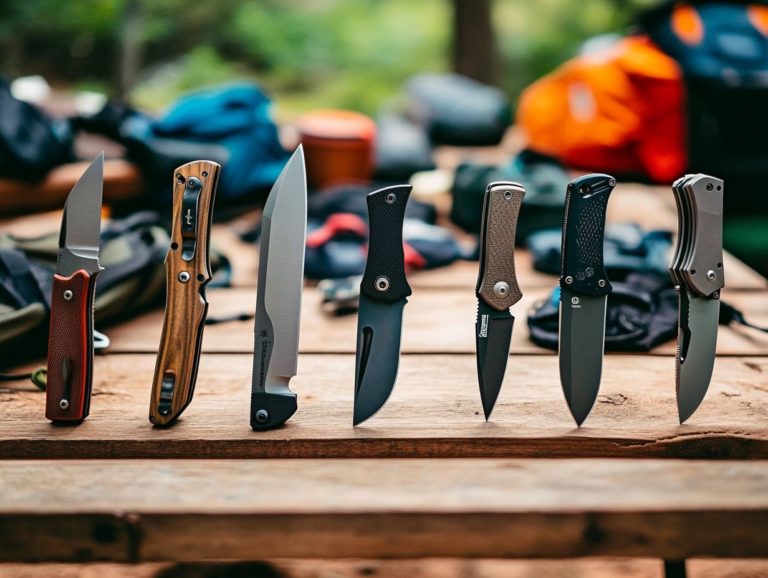Best Climbing Gear for Camping Adventures
Planning a camping adventure that involves climbing? The right gear can transform your experience from merely thrilling to truly exhilarating.
Whether it s your first ascent or tackling towering cliffs, having the appropriate equipment not only boosts your performance but also prioritizes your safety.
This guide delves into the essential climbing gear required for your outdoor excursions. From climbing shoes to first aid kits, uncover the must-have items that will set you up for an unforgettable adventure. Don t miss out on the right gear that can elevate your climbing experience!
Contents
- Key Takeaways:
- 1. Climbing Shoes
- 2. Harness
- 3. Rope
- 4. Carabiners
- 5. Belay Device
- 6. Helmet
- 7. Chalk Bag
- 8. Quickdraws
- 9. Cams
- 10. Nuts
- 11. Slings
- 12. Climbing Backpack
- 13. Headlamp
- 14. Climbing Guidebook
- 15. First Aid Kit
- Frequently Asked Questions
- What is the best climbing gear for camping adventures?
- What type of tent is best for climbing and camping?
- Do I need a specific sleeping bag for climbing and camping?
- What should I look for in a camping stove?
- What is the most important climbing equipment to bring on a camping trip?
- How do I choose the right backpack for camping and climbing?
Key Takeaways:
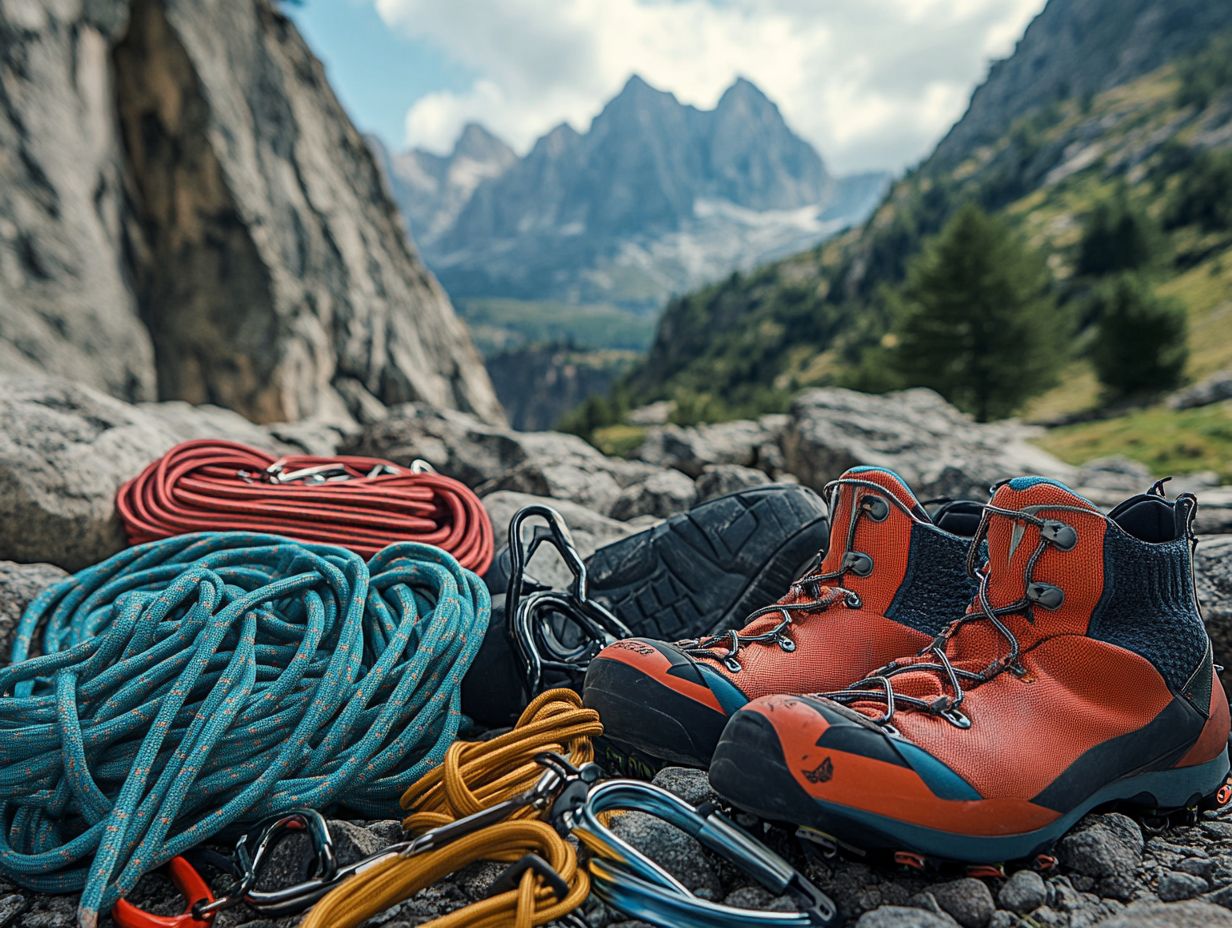
- A good pair of climbing shoes provides the necessary grip and support for successful camping adventures.
- A harness is essential for safety and allows for easy attachment to safety gear.
- A high-quality rope is crucial for safe and efficient climbing, so choose one that is durable and has a suitable length and thickness.
1. Climbing Shoes
Selecting the right climbing shoes is crucial for optimizing your performance on Denali, especially when navigating the challenging terrains of the Ruth Glacier. Here, precision and grip are necessities for your outdoor climbing escapades.
Fit and comfort in climbing shoes are vital. They ensure optimal foot placement and stability on demanding routes. Consider models like the Scarpa Phantom 6000, La Sportiva Olympus Mons, and Feathered Friends Down Booties, crafted to offer warmth and support essentials for unpredictable weather conditions typical of high-altitude climbs.
A well-fitted shoe enhances your climbing efficiency and reduces the risk of foot injuries caused by poor circulation or discomfort. With the right footwear, you can concentrate on your ascent, making every foothold count without distractions.
2. Harness
A climbing harness is an essential piece of high-quality gear that guarantees both safety and comfort during your adventurous excursions, particularly in challenging terrains like the Canadian Rockies or the Himalayas.
Various types of climbing harnesses cater to different preferences and climbing styles. You might prefer lightweight options for alpine ascents or more robust designs for sport or trad climbing.
Prioritize adjustability; a harness that easily adapts can accommodate layers of clothing and varying body types, ensuring it remains versatile and user-friendly. Comfort is crucial too look for good padding and breathability, as these elements significantly impact how long you can comfortably stay in a harness without feeling restricted.
A well-fitting harness enhances your climbing experience and maximizes safety, allowing you to focus on your performance without distractions.
3. Rope
Selecting the right rope is crucial for your climbing safety and performance. The type and quality of rope you choose can greatly influence your climbing journeys, especially in challenging winter conditions.
Understanding the different types of climbing ropes is essential. For instance, dynamic ropes stretch upon impact, making them perfect for rock climbing and lead climbing scenarios where falls can happen. Conversely, static ropes have minimal stretch and are ideal for rappelling, canyoneering, and rescue operations. Your decision between single, half, or twin ropes is vital for safety. Generally, single ropes are favored for sport climbing, while half and twin ropes offer greater versatility for alpine and multi-pitch climbs.
Choosing the right rope not only boosts your performance but also keeps you safe in various environments, ultimately enhancing your overall outdoor experience.
Gear up now and take your climbing to the next level!
4. Carabiners
Carabiners are important safety features for climbers. They help link your harness to ropes and other gear, ensuring a seamless climbing experience.
Understanding the difference between locking and non-locking carabiners is vital for climbers who want to maximize safety and efficiency.
Locking carabiners have a mechanism that secures the gate. They are especially important in situations like belaying or tackling multi-pitch routes, where accidental unloading can lead to dangerous falls.
On the other hand, non-locking carabiners are ideal for lighter tasks. They are perfect for anchoring or connecting accessories where quick access is needed. By choosing the right type for your climbing scenario, you enhance your safety and elevate your overall performance on the rock face.
5. Belay Device
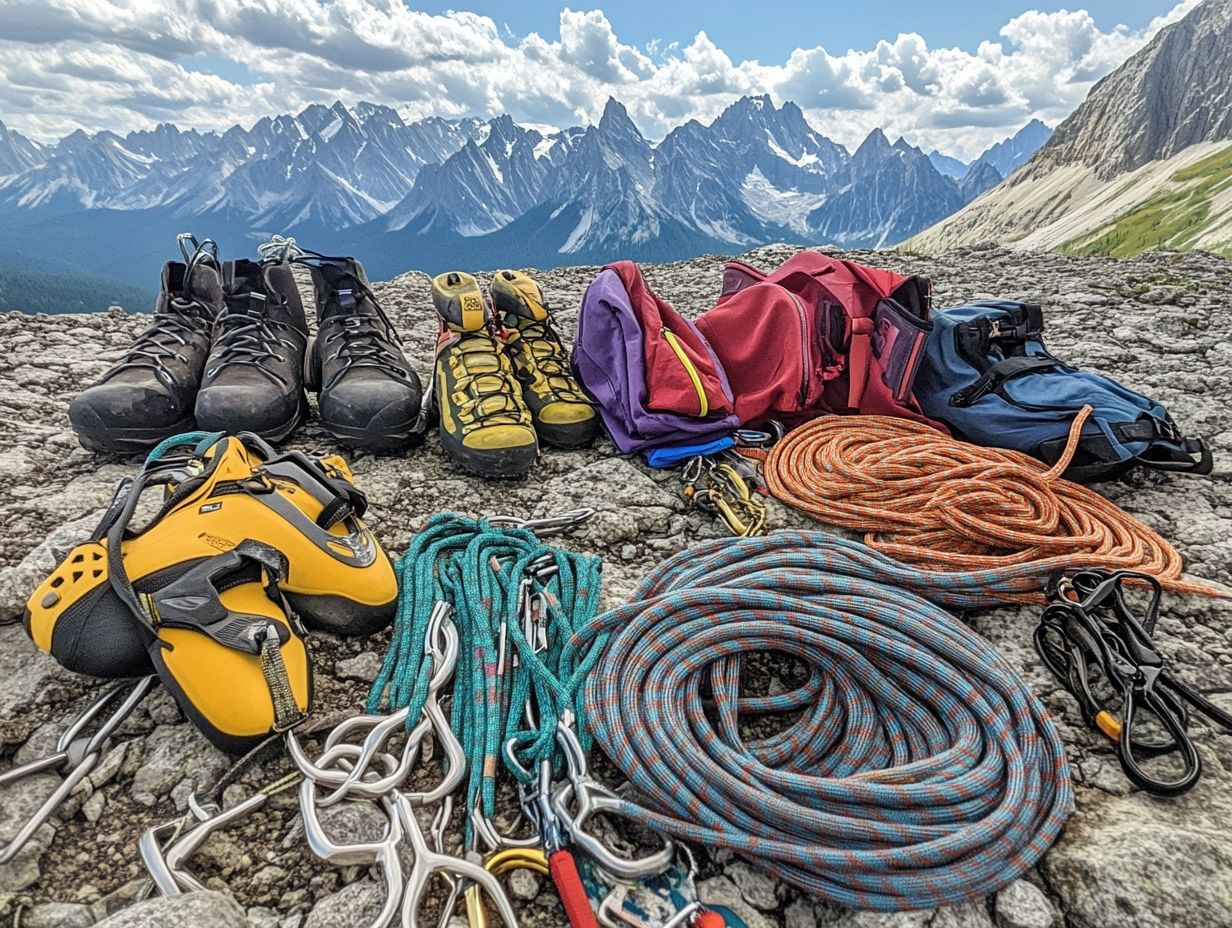
A belay device is essential for your climbing safety. It allows you to manage rope control effectively during both lead and top-rope climbing.
Understanding the various types of belay devices can significantly enhance your experience and safety on the wall.
- Common options include tubular devices, which create friction to manage slack and ensure smooth feeding.
- Assisted-braking devices add an extra layer of security by automatically locking the rope in the event of a fall.
These mechanisms ensure you, as the belayer, are prepared to handle situations requiring quick reactions.
When climbing in multi-pitch scenarios or with beginners, choosing the right belay device is critical. It can prevent accidents and help you manage potential falls effectively.
Make sure to familiarize yourself with each type and its specific benefits. This knowledge allows you to make informed choices tailored to your climbing style and environment.
6. Helmet
Wearing a helmet while climbing is a must for your safety! It shields you from falling rocks and other hazards, making it essential for any outdoor adventure on Denali or similar terrains.
Various types of climbing helmets are available. Each is crafted with specific features tailored for different conditions.
Some models are lightweight and well-ventilated, perfect for alpine climbs. Others offer robust protection with reinforced shells designed for more technical ascents and work well with North Face mittens and Smartwool socks.
Integrating a helmet into your climbing gear lineup is critical; it s your last line of defense against unpredictable dangers.
Countless climbers have walked away unscathed after being struck by falling debris, thanks to their helmets absorbing the impact. These scenarios highlight the undeniable importance of prioritizing head protection on your elevated adventures.
7. Chalk Bag
A chalk bag may be small, but it s an essential accessory for climbers. It helps maintain grip and elevate your performance, especially on challenging routes and in unpredictable weather.
These bags come in various designs, materials, and sizes, each crafted to meet specific climbing needs. Some feature a traditional drawstring closure, while others use magnetic or velcro systems for easy access to chalk.
Many bags also offer handy extras like belt loops or storage pockets, ensuring your gear is always within reach.
Regarding chalk, the choice between loose or ball form matters significantly. It influences moisture absorption and ease of application. To maximize your grip on climbs, opt for finely milled chalk and apply it evenly.
This attention to detail can dramatically enhance both your climbing efficiency and your confidence on the rock.
8. Quickdraws
Quickdraws are essential for your climbing safety and efficiency. They allow you to easily connect ropes to protection points as you navigate routes on Denali and beyond.
By understanding the different types of quickdraws ranging from sturdy carabiners (the clips that attach the rope to the anchor) to various lengths of dogbone (the connector between two carabiners) you can significantly enhance your climbing experience. Each type caters to specific needs. For instance, some are lightweight and perfect for alpine climbing, while others are robust enough for traditional routes.
To use quickdraws effectively, make sure to properly thread the rope through the linear end (the end that doesn t open) and securely close the carabiner gate (the movable part of the carabiner). Always check for wear and tear to stay safe! Be especially mindful of how you place quickdraws on overhangs or traverses, where excessive force can come into play. Proper use not only elevates your safety but also streamlines your ascents.
9. Cams
Cams are sophisticated protection devices that improve your climbing safety by providing secure anchor points in rock formations an absolute must when you’re tackling the rugged terrains of the Ruth Glacier.
Grasping the nuances of different types of cams, like single axle (with one pivot point) and dual axle (with two pivot points), along with specialized variants, can significantly influence your gear selection and overall safety. For example, dual axle cams offer a broader range of placement options, seamlessly adapting to flared cracks, whereas single axle models excel in straightforward placements, making them crucial for alpine climbing in places like Denali.
To maximize the benefits of these devices, familiarize yourself with their mechanics and assess the climbing context carefully. By recognizing the strengths each type brings to various climbing scenarios, you can make informed choices that enhance your protection systems, leading to a safer and more enjoyable climbing experience.
10. Nuts
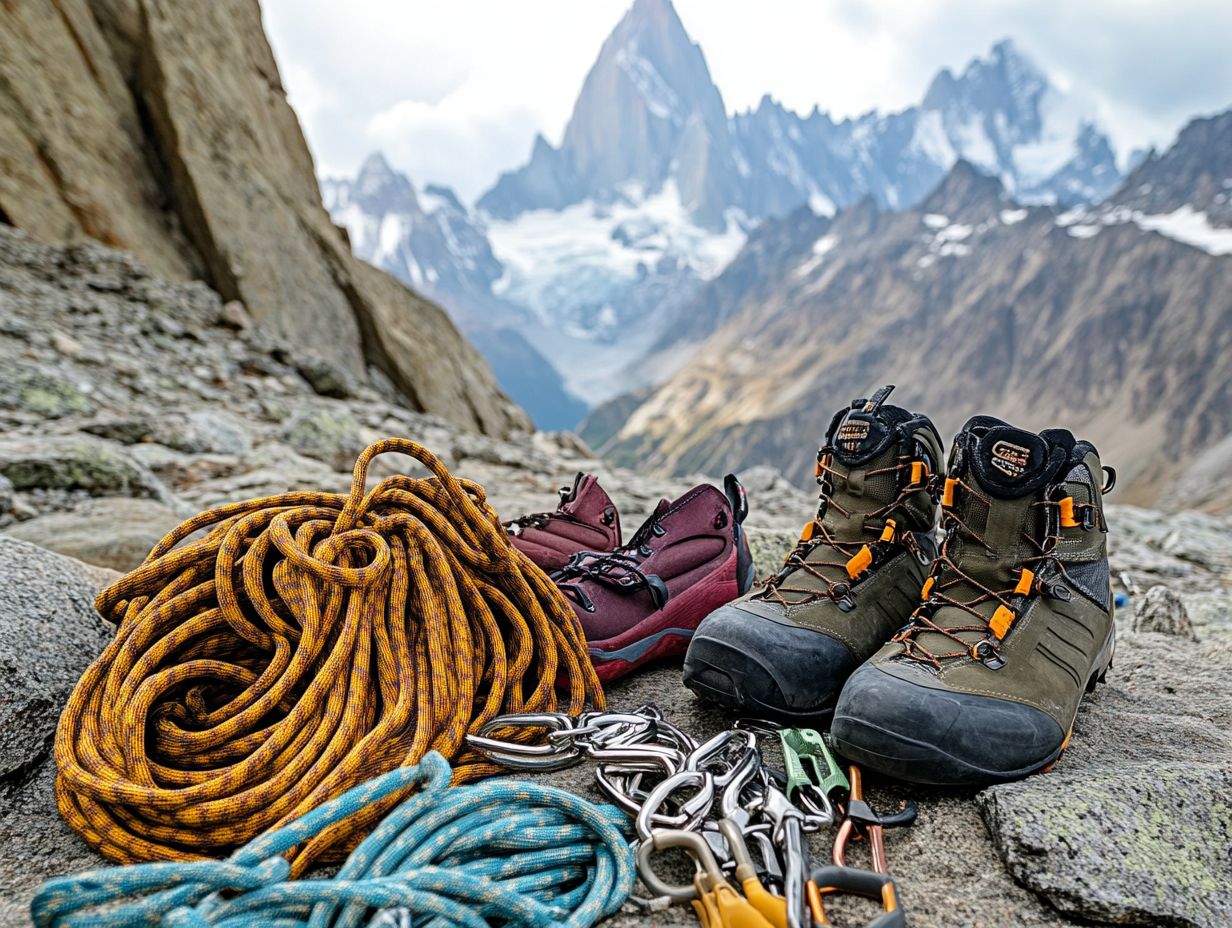
Nuts are essential pieces of climbing gear that provide crucial protection. They allow you to secure anchor points in cracks and crevices, optimizing your climbing performance.
These small yet mighty devices come in various shapes and sizes, each crafted to fit different types of rock formations. You ll often use hexes (six-sided nuts), stoppers (small, tapered nuts), and tapered nuts each offering distinct advantages depending on the situation. For example, stoppers slide effortlessly into narrow fissures, delivering a reliable hold, while hexes shine in wider placements, providing superior stability.
The versatility of these nuts makes them a preferred choice over some alternatives, as they tend to be lighter and easier to handle. In scenarios where quick placements are essential, such as on steep terrain, these devices can significantly enhance not just your safety but also your overall efficiency, especially in varying weather conditions.
11. Slings
Slings are your versatile allies in climbing safety, serving multiple purposes such as anchoring, extending protection, or creating secure connections. They boost your confidence as you scale those heights.
You ll find slings made from various materials, including nylon and dyneema (a high-strength material), each tailored for specific climbing scenarios. For intricate routes, longer slings are ideal for extending protection placements and reducing rope drag. Conversely, shorter slings are perfect for building solid anchors.
In the unpredictable realm of alpine climbing, the lightweight and durable nature of modern slings becomes essential for maintaining efficiency and speed, especially when temperatures plunge during nighttime. For those planning family camping trips, choosing the best camping gear for family outings can significantly elevate your overall climbing safety, letting you focus on the ascent rather than worrying about your equipment’s reliability.
12. Climbing Backpack
A climbing backpack is a must-have item that allows you to carry your equipment and supplies efficiently. It ensures that your camping gear is organized for a successful climbing trip.
When choosing the right pack, consider several key features. Size is crucial; it should align with the duration and type of your trips, whether you’re heading out for a short day hike or an extended multi-day expedition. Straps are another critical element. Adjustable and padded shoulder straps enhance your comfort, especially when toting heavy loads.
Organization is vital, and compartments play a significant role in keeping everything in its place. Dedicated pockets for gear like carabiners, ropes, and first-aid supplies ensure that your essentials are easily accessible. For instance, if you’re setting out on a bouldering adventure, you might prefer a smaller, streamlined pack. In contrast, alpine climbers could benefit from a larger option equipped with extra weatherproofing to keep gear dry in changing conditions. When choosing your pack, consider the top features to look for in camping gear to make the best choice.
13. Headlamp
A headlamp is an essential safety tool for climbers, providing crucial lighting during nighttime ascents or emergencies. It s a must-have accessory for any outdoor adventure.
When selecting the right headlamp, consider several key features that impact performance. Brightness is crucial; lumens measure light brightness, which is vital for navigating rocky terrains or locating gear in the dark. This is especially important when relying on your climbing gear in winter conditions.
Battery life is equally important. A dependable battery keeps your light shining when it matters most. The weight of the headlamp also affects comfort, especially during extended climbs where every ounce counts. This is crucial when carrying lightweight tents and other camping gear.
By assessing these factors, you’ll ensure that your chosen model meets the demands of various climbing situations, enhancing your climbing efficiency and overall safety.
14. Climbing Guidebook
A climbing guidebook is an essential companion, providing detailed insights on routes, conditions, and critical safety tips. This enhances your outdoor climbing experiences, especially in formidable locations like Denali, where proper gear recommendations are vital for safety.
These comprehensive resources illuminate potential hazards and necessary gear while offering guidance on the optimal times of year for specific climbs. In lesser-known terrains, a well-curated guide can be the difference between a thrilling adventure and a perilous expedition, particularly considering weather conditions that affect climbing performance.
Consider these essential guidebooks for your journey:
- Mountaineering: The Freedom of the Hills – a timeless resource filled with expert advice.
- Climb: A Complete Handbook for Beginners – perfect for newcomers and those seeking budget gear options.
Digital platforms such as Mountain Project and Climbing.com enhance your climbing experience by providing real-time updates on conditions and community advice. They offer recommendations for gear confidence, including the best lightweight camping gear for backpackers, and cooking systems for your camping nights, making them invaluable allies in your pursuit of climbing success.
Stay updated on conditions to ensure a safe adventure!
15. First Aid Kit
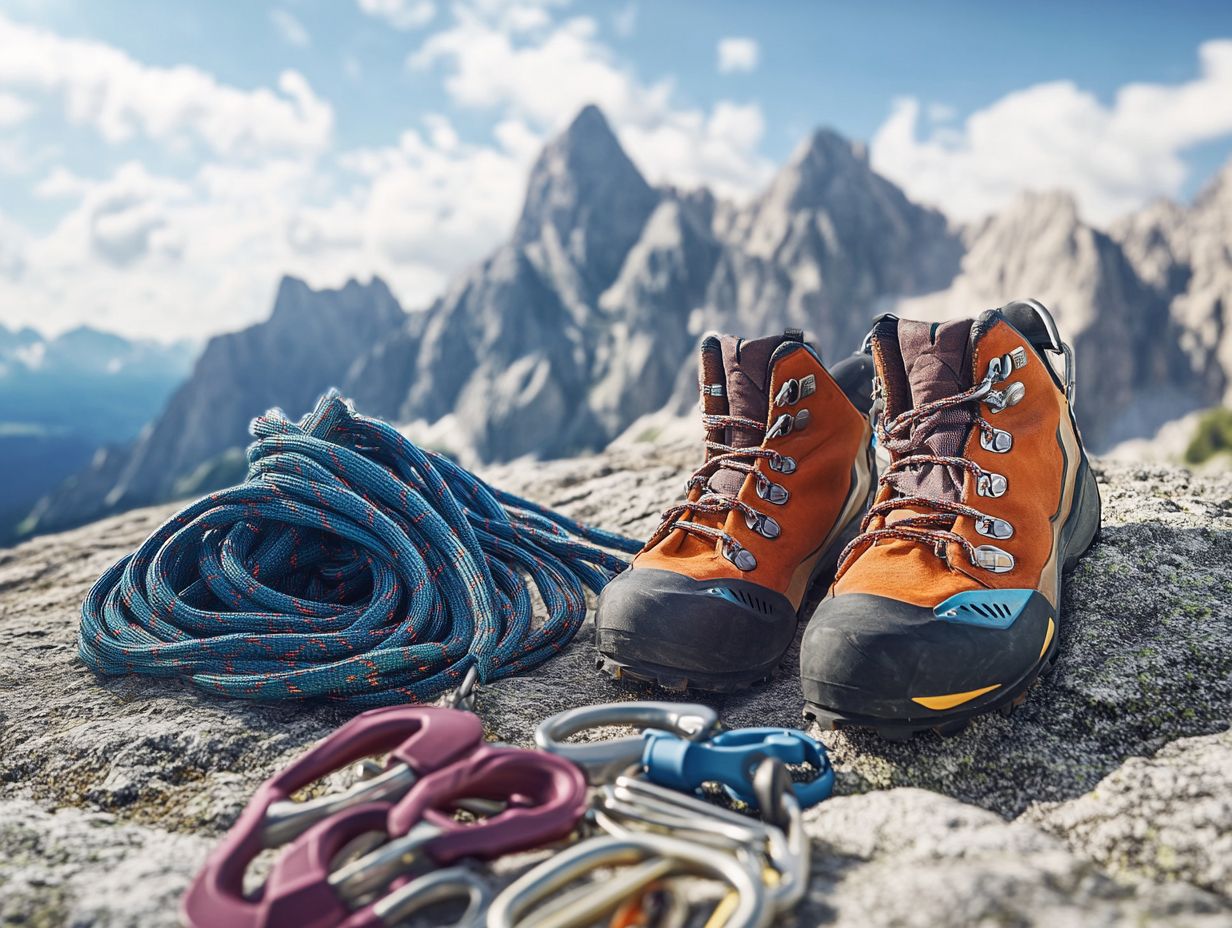
A well-stocked first aid kit is absolutely essential for your climbing safety, equipping you with the necessary tools to handle injuries and emergencies that may arise during your outdoor adventures, particularly in high-altitude areas like the Himalaya.
This kit should include items such as insulated bags that help keep food warm and other essentials:
- Adhesive bandages for those minor cuts
- Gauze pads for larger wounds
- Antiseptic wipes to help prevent infection
Incorporating a splint and an elastic bandage can prove very useful for stabilizing sprains or fractures. This allows for swift and effective treatment.
Don t forget a pair of tweezers; they re crucial for removing pesky splinters or insect stings, particularly when you re far from your gear.
Make sure to learn about these tools and their applications. Check your kit regularly to ensure that all items are intact and ready for immediate use in case of an emergency. This knowledge makes your climbing experience safer and more enjoyable.
Watch this video to learn more about packing your first aid kit.
Frequently Asked Questions
What is the best climbing gear for camping adventures?
The best climbing gear for camping adventures includes a sturdy and versatile tent, a durable sleeping bag, a reliable camping stove, comfortable and supportive hiking boots, a high-quality backpack, and essential climbing equipment such as ropes and harnesses.
What type of tent is best for climbing and camping?
A 4-season tent is the best choice for climbing and camping as it can withstand harsh weather conditions, strong winds, and heavy rain, ensuring that your nights camping are comfortable and safe. It also provides better insulation and ventilation compared to other types of tents.
Do I need a specific sleeping bag for climbing and camping?
Yes, a sleeping bag designed for camping and climbing is essential. Look for a sleeping bag with lightweight insulation, water-resistant materials, and a compact design for easy transport, such as the Therm-a-Rest sleeping bag. It should also provide enough warmth and comfort for your desired temperature range.
What should I look for in a camping stove?
When choosing a camping stove, look for one that is lightweight, compact, and durable, as well as weather-resistant gear for outdoor conditions. It should also be easy to set up and have a stable base for safe cooking. Consider the fuel type, cooking time, and number of burners as well.
What is the most important climbing equipment to bring on a camping trip?
The most important climbing equipment to bring on a camping trip includes a climbing rope, harness, helmet, carabiners, and climbing shoes, which should always be of premium quality for enhanced safety during challenging climbs.
How do I choose the right backpack for camping and climbing?
When choosing a backpack for camping and climbing, look for one with a sturdy and comfortable frame, adjustable straps, and multiple compartments for organized storage. It should also be able to carry all your necessary gear, including warm gear, and have a water-resistant design for outdoor use.

